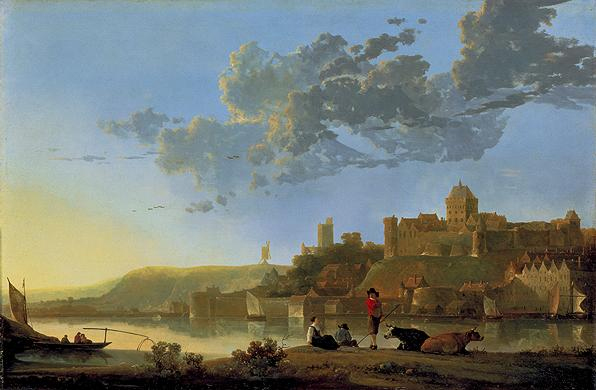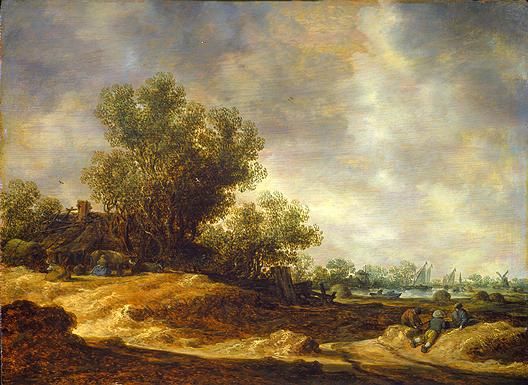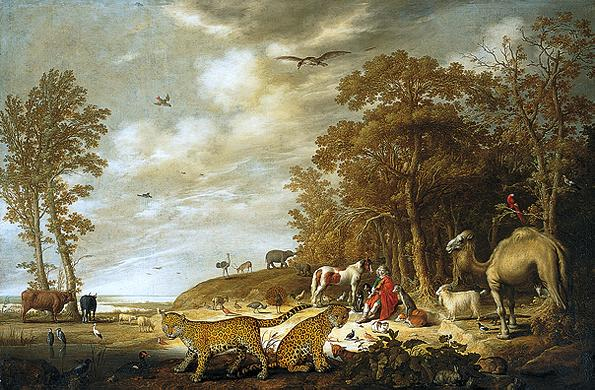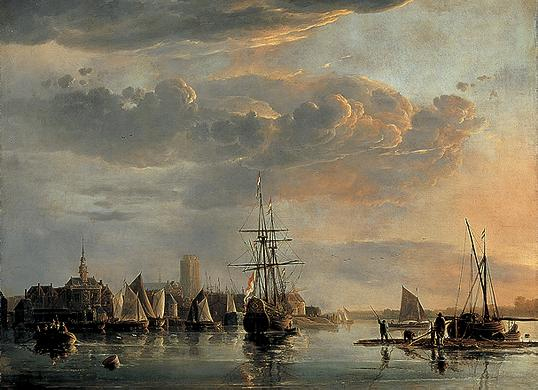Aelbert Cuyp

Introduction
Aelbert Cuyp (1620 - 1691), one of the foremost landscape painters of the Dutch golden age, is particularly known for evocative representations of the Dutch countryside drenched in an atmospheric golden light. He also painted a number of biblical and mythological pictures as well as an occasional portrait. An exceptional draftsman, he created sensitive drawings of the countryside, many of which served as models for his paintings. Quiet in atmosphere and grand in appearance, Cuyp’s paintings and drawings had an enormous appeal for the English aristocracy of the later eighteenth century and for American collectors of the late nineteenth and early twentieth centuries. The present show is the first international loan exhibition devoted entirely to the work of this extraordinary artist.
Aelbert Cuyp, The Valkhof at Nijmegen from the Northwest, mid-1650s, 19 1/4 x 29 in., Indianapolis Museum of Art

Life and Work
Aelbert Cuyp came from a family of artists that had settled in Dordrecht, an old and prosperous town located at the junction of several major waterways, among them the Maas River. His grandfather Gerrit was a glazier and his father Jacob, a successful portrait painter who enjoyed the patronage of local aristocrats and members of the upper middle class.
Romeyn de Hooghe, Dordrecht, from Matthijs Balen, Beschryvinge der stad Dordrecht (Dordrecht, 1677), National Gallery of Art Library, Washington, Gift of David K. Bruce

During the 1630s, the young Aelbert trained with his father, and in the early 1640s the two artists collaborated, with Jacob executing the portraits and Aelbert the landscapes.
Jacob and Aelbert Cuyp, Portrait of a Family in a Landscape, 1641, 61 x 96 7/16 in., Collection the Israel Museum, Jerusalem, Gift of Mr. and Mrs. Joseph R. Nash, Paris

By that time, Aelbert had already begun to paint independent works. Many of these were small-scale landscapes, such as River Scene with Distant Windmills, which depict Dutch farmland and waterways, and suggest the quiet harmony of man and nature.
Aelbert Cuyp, A River Scene with Distant Windmills, early 1640s, 14 x 20 5/8 in., The National Gallery, London

Native subject matter and a similarly narrow color range, primarily ochres and greenish browns, were prevalent during the 1630s and early 1640s, a period known as the tonal phase of Dutch landscape painting. Cuyp may have become acquainted with this style through the work of Jan van Goyen (1596 - 1656).
Jan van Goyen, Dutch, 1596 - 1656, Dune Landscape, 1634, oil on panel, Private Collection

Like many early seventeenth-century Dutch landscapists and marine painters, Aelbert Cuyp captured the essential harmony of humanity and nature, whether depicting farmers or shepherds in their fields, skaters enjoying the ice on a cold winter’s day, or ships gliding gracefully over inland waterways.
Simon de Vlieger, Dutch, 1600/1601 - 1653, Estuary at Dawn, c. 1640/1645, oil on panel, Patrons’ Permanent Fund and The Lee and Juliet Folger Fund in memory of Kathrine Dulin Folger, 1997.101.1

Cuyp also painted mythological and biblical scenes. A particularly ambitious large-scale picture of this type, painted early in his career, depicts the mythological hero Orpheus charming animals with his singing and playing. The scene may allude to harmonious leadership: just as Orpheus tames different animals with his music and eloquence, a good leader unites the various segments of society. The subject gave Cuyp the opportunity to depict a wide variety of animals, even rare species that he had probably never seen. For example, the jaguars in the foreground (which are less detailed in their execution than the horse behind them), may have been based on a print, and the pangolin (the spiny Asian mammal at right), on a stuffed specimen from an aristocratic Cabinet of Wonders.
Aelbert Cuyp, Orpheus Charming the Animals, c. 1640, 44 1/2 x 65 3/4 in., Private collection, Boston

About 1640, Aelbert Cuyp traveled widely in the Netherlands, making drawings of Utrecht, The Hague, Amersfoort, Arnhem, and Rhenen. He made frequent visits to Utrecht, where his father had trained as an artist.
Aelbert Cuyp, Utrecht with the Vecht River and the Pellekussenport, c. 1639, 61 5/16 x 12 1/8 in., Staatliche Museen zu Berlin, Kupferstichkabinett

In Utrecht, Aelbert may have met the landscape painter Jan Both (d. 1652), who pursued a career painting large-scale, Italianate landscapes bathed in golden light after he had returned from Italy in 1641. In the mid-1640s Cuyp's palette became more colorful, and, perhaps inspired by Jan Both's Italianate scenes, his landscapes began to incorporate hilly terrains suffused in the soft golden glow of early morning or evening light. While some of these landscapes are fanciful, others depict hills, the Grebbeberg for instance, that he encountered on his travels along the Rhine River to the eastern Netherlands.
Jan Both, Dutch, 1615/1618 - 1652, An Italianate Evening Landscape, c. 1650, oil on canvas, Patrons' Permanent Fund, 2000.91.1

By 1645, Cuyp had developed the visual vocabulary that he would continue to use throughout his career. Bathing his scenes in an enchanting atmospheric light and using a relatively low viewpoint, he created a sense of grandeur, whether depicting a meadow with grazing cows, farm buildings, waterways, the ruins of a historic monument, or the graceful cityscape of his hometown of Dordrecht.
He was also able to capture the dynamism of a historic event. In The Maas at Dordrecht, the assembly of the Dutch fleet in July 1646 is represented as a symbolic show of force on the eve of peace negotiations with the Spanish, with whom the Dutch had been at war since their revolt against Spanish rule in 1568. The large number of ships, each crowded to capacity, signifies the importance of the event. As one ship fires a salute, a drummer on the large sailing ship in the foreground announces the arrival of city dignitaries. Cuyp evoked the drama of the scene through the restless succession of sunlit sails, the dramatic cloud formations, and the flickering effects of light on the water.
Aelbert Cuyp, Dutch, 1620 - 1691, The Maas at Dordrecht, c. 1650, oil on canvas, Andrew W. Mellon Collection, 1940.2.1

In the early 1650s, Cuyp once again traveled east along the Rhine. After passing the city of Nijmegen and its medieval citadel The Valkhof, he reached Germany, where the river is flanked by steep hills. He recorded these scenes in drawings that remained a constant source of artistic inspiration throughout the 1650s. Many of these drawings --like those of the flat river landscape surrounding his native Dordrecht-- have a wide, panoramic format that Cuyp also used for some of his most majestic paintings of this period.
Even though Cuyp enjoyed considerable success as a painter, he seems to have painted less frequently in the waning years of his life. This development may relate to his 1658 marriage to Cornelia Boschman, the widow of a wealthy regent. During the 1660s and 1670s, he was also active as deacon and elder of the Reformed Church, regent of the sickhouse of the Grote Kerk in Dordrecht, and member of the High Court of Holland.
Aelbert Cuyp, Two Horsemen on a Ridge, c. 1646 - 1648, 13 x 16 3/4 in., Private collection, New York

Patrons
Cuyp seems to have made most of his pictures for members of the aristocracy and upper middle class of Dordrecht, such as the wealthy Pompe van Meerdervoort family, whose sons he depicted in a large-scale portrait. On horseback, with a tutor and a coachman at their side, Michiel and Cornelis Pompe van Meerdervoort are shown departing for the hunt, a popular aristocratic pastime illustrative of the family's social standing.
Interestingly, the men in this painting wear a combination of Hungarian outfits, fanciful headgear, and contemporary Dutch boots. These costumes seem to have been studio props, for they appear in several of Cuyp's paintings and were probably seen as a dignified mode of dress. Since Hungarians were known for their proficiency in hunting, Cuyp and his patrons may have associated their garb with that skill. They may also have felt an affinity with Hungarians because of their shared Protestant faith (like Cuyp, the Pompe van Meerdervoorts belonged to the Calvinist or Reformed Church).
Aelbert Cuyp, Michiel and Cornelis Pompe van Meerdervoort with Their Tutor, c. 1652 - 1653, 43 1/4 x 61 1/2 in., The Metropolitan Museum of Art, New York, The Friedsam Collection, Bequest of Michael Friedsam

Dordrecht was an important center of the Reformed Church in the seventeenth century: a number of theological disputes were decided in the Synod of Dordrecht of 1616-1618, and the standard Dutch translation of the Bible was completed in the city. Significantly, Cuyp repeatedly depicted a biblical subject that was of particular importance to Calvinists: The Baptism of the Eunuch. The story (Acts, 8.26:40) concerns a eunuch, the Ethiopian queen's treasurer, who on his way back from a pilgrimage to Jerusalem met Saint Philip. The eunuch, after inviting Philip to ride with him, asked the saint questions about the Bible, which Philip carefully explained. As they passed by a river, the eunuch asked to be baptized. Philip agreed only after the eunuch confirmed that he believed with all his heart.
This biblical story appealed to Calvinists because, contrary to Catholics, they believed that one should be baptized only after one had consciously decided to follow Christian beliefs. Cuyp's painting of the story would have been intended for a private setting. After the violent destruction of church images during the iconoclasm at the end of the sixteenth century, the Reformed Church did not allow religious images in church.
Aelbert Cuyp, The Baptism of the Eunuch, c. 1642 - 1643, 42 1/2 x 59 1/2 in., The Menil Collection, Houston

Ideals of a Golden Age
The almost magical light effects and general sense of tranquility in Cuyp's pictures may relate to contemporary ideals (already current at the very beginning of the century) of a Dutch golden age. The term denoted an idyllic era in which man lived in peace and harmony with nature, recalling the golden age described by the ancient Roman writer Ovid. Although peace would not be achieved in the Netherlands until the end of the Eighty Years' War with Spain in 1648, the Twelve-Year Truce of 1609-1621 had already inspired many to believe that the Netherlands was entering a splendid period of economic prosperity and spiritual well-being.
The Dutch also likened their land to arcadia, another idyllic paradise. This ancient mythic retreat, populated by romantically inclined shepherds, shepherdesses, nymphs, and satyrs, was frequently evoked in contemporary poems, prose, and plays. In the 1630s a new literary genre appeared in the Netherlands, describing the Dutch countryside as if it were this mythic retreat. These texts, known as Arcadiae, were inspired by similar Italian, English, and Spanish literary traditions and became increasingly popular throughout the seventeenth century. In Lambert van den Bos' Dordrechtsche arcadia (1662), glorious descriptions of the surroundings of Dordrecht are strikingly similar in character to Cuyp's images of his native city. Like the ferry passengers at the left of Cuyp's Dordrecht from the North, travelers in Van den Bos' book cross the river Merwede and enjoy the gentle early evening air. Despite their different forms of expression, Cuyp and Van den Bos both combine a profound sense of place and history with an idyllic atmosphere of peace and tranquility.
Aelbert Cuyp, Dordrecht from the North, mid-1650s, 38 1/2 x 54 1/4 in., English Heritage (The Iveagh Bequest, Kenwood)

The sense of well-being pervading a great number of Cuyp's more rural pictures parallels the keen appreciation for country life evident during Cuyp's day. Not only were an increasing number of country houses built around midcentury, but the pleasures of country life were also frequently celebrated in so-called hofdicht or country house poems. They, like Cuyp's pictures, evoke the spiritual nourishment to be found in nature.
The Dutch countryside was fertile and its inhabitants were able to stretch its limits, using dikes and windmills to gain new land. They attributed their prosperity to God's blessing and compared themselves to the ancient Israelites, God's chosen people. According to William Temple, a seventeenth-century English traveler, the Dutch even called their country vaderland (fatherland), a term otherwise reserved exclusively for the Holy Land, the destination of every Christian pilgrim. Cuyp appears to have incorporated such spiritual ideas in his landscapes. As the Calvinists did not approve of depictions of God in human guise, allusions to God's presence were subtlely indicated, whether through a centrally located church or spectacular light effects such as the beams breaking through the billowing clouds in Cuyp's River Landscape with Cows.
Aelbert Cuyp, River Landscape with Cows, 1645/1650, oil on panel, Gift of Family Petschek (Aussig), 1986.70.1

Drawings
Aelbert Cuyp was inspired by the drawings of a number of early seventeenth-century Dutch artists who had recorded the inland waterways, woods, and farmlands of the surrounding countryside. Many of these works were done in black chalk in sketchbooks carried into the countryside. More elaborate landscape drawings, such as Willem Buytewech's depiction of a meadow with carefully colored cows and shepherd, were often finished in the studio. Such drawings were intended to be sold as independent works of art.
Willem Buytewech, Dutch, 1591/1592 - 1624, Meadow with a Shepherd and Cows, 1617, black and red chalk, and pen and brush with brown ink, William Nelson Cromwell Fund, 1977.61.1

Cuyp filled numerous sketchbooks with panoramic views, often with distant city profiles silhouetted against the horizon, depictions of villages nestled along inland waterways, and detailed studies of figures, animals, or plants. Many of these drawings are remarkable for their painterly qualities, which Cuyp evoked using colored washes and gum arabic, a varnish-like medium that heightens the intensity of the foreground landscape elements in his Dordrecht Viewed from the East. While the careful finish suggests that this drawing was an independent work of art, Cuyp may also have used it as a model for one of his paintings, which often combine motifs from different drawings. Cuyp most likely painted in his studio, a common practice at the time, rather than directly from nature.
Aelbert Cuyp, Dordrecht Viewed from the East, early 1640s, 7 1/2 x 17 1/2 in., Rijksmuseum, Amsterdam (no.72)

Posthumous Reputation
After his death in 1691, Cuyp's fame grew steadily. The greatest collector of his paintings was the eighteenth-century Dordrecht iron dealer and mintmaster Johan van der Linden van Slingeland, who owned forty-one works by the artist. After the sale of his collection in 1785, many of these paintings entered collections in England, where Cuyp's works were greatly admired for their grandeur.
From the mid-eighteenth century onward, the enthusiasm for his paintings was so great in England and France that by 1800 no significant work by the master was left in the Netherlands. Since then, Cuyp's fame has spread even further and many of his finest works are now in American collections, among them masterpieces once owned by Van Slingeland. The present exhibition reunites more than forty of Cuyp's paintings for the first time in over two hundred years, presenting them along with some forty-five of the master's drawings.
Aelbert Cuyp, Dutch, 1620 - 1691, The Maas at Dordrecht, c. 1650, oil on canvas, Andrew W. Mellon Collection, 1940.2.1